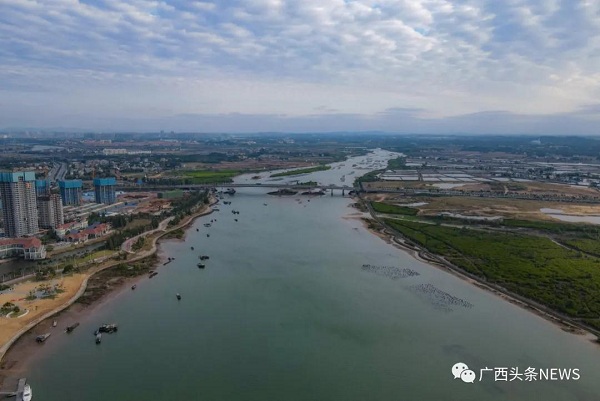Guangxi canal proposed by Sun Yat-sen to start construction in 2022

Aerial view of Qinzhou's Shajing Port. [Photo/WeChat account: cns-gx]
The dream of Sun Yat-sen, the forerunner of China's democratic revolution, to build a canal that connects the Pearl and Xijiang rivers as well as the Beibu Gulf will come true as Pinglu Canal is set to start construction in 2022.
The proposal was made in the 2022 government work report during the fifth session of the 13th Guangxi Zhuang Autonomous Regional People's Congress, which opened on Jan 17 in Nanning.
The 140-kilometer canal will be built at a cost of around 68 billion yuan ($11 billion) and is the first canal in China that connects rivers and seas since 1949.
It starts from Pingtang River's estuary of Xijin Reservoir in Nanning's Hengzhou and merges with Qinjiang River at Luwu town of Qinzhou's Lingshan county before heading towards the sea at Qinzhou's Shajing Port.
Around 120 km of the canal is in Qinzhou, passing through 17 towns (communities) in four counties and districts, covering nearly 60 percent of Qinzhou's population and around 50 percent of regional GDP.
A six-km river channel able to handle 3,000 metric ton vessels will be built with an annual cargo handling capacity of 100 million tons upon operation.
The canal will become the most convenient shipping channel for China-ASEAN trade, allowing ASEAN cargo to reach markets in the Chinese mainland in a cheaper and more convenient way, said Lei Xiaohua of Guangxi Academy of Social Sciences.
Planning for issues such as land, industry, transport, and ports has been underway. An intercity railway from Yulin to Qinzhou will also be built to help achieve a deep integration among the Guangdong-Hong Kong-Macao Greater Bay Area, the economic belt alongside the canal, and the Beibu Gulf city cluster.
Nanning officials noted that the city will devote great efforts to supporting the development of whole shipping industry chains and enhance cooperation with countries and cities alongside the New International Land-Sea Trade Corridor.
Chen Hongqi of the Transport Department of Guangxi Zhuang Autonomous Region noted that exporting cargos from Nanning on the canal via Qinzhou Port can save over 560 km of travel to 291 km compared with the traditional way for export via Guangdong.














